Abstract
Ben Lawers is Britain’s primary site for rare arctic-alpine flora, and I have been fortunate to work here since 2010, initially as a volunteer, and then as an NTS ecologist. Spring and summer 2020 were unusual because I only climbed the mountain once this year. However it ended up being an absolutely stunning botanical day out. The experience brought me so much joy that I knew I had to share it. There are also vital contributions from aspiring young botanists Georgia (aged 6) and Felix (aged 4)! If you enjoyed reading, then please give me a follow on twitter @Watts_SHI was employed by the National Trust for Scotland from 2013-2020 as an ecologist at Ben Lawers NNR, Britain’s best site for rare plants and arctic-alpine flora. In a typical summer I would climb Ben Lawers (1214m) and its surrounding peaks on very regular basis to undertake monitoring of nationally important habitats and plant populations. However, as we are all aware, 2020 proved unusual and I found myself on furlough leave and unable to work at this remarkable upland location. I only went up Ben Lawers and neighbouring Beinn Ghlas once this year (9th August), but it would turn out to be the most wonderful single-day botanical experience I have had yet.
The initial purpose of the outing was a family hill walk up the two Munro summits. Georgia (aged 6) and Felix (aged 4) took the adventure in their stride, and since the weather was unusually good for August, I suggested that we make a detour on our descent from the summit of Ben Lawers. We would walk past the known botanical hot spots “just to have a look”. However, it soon became clear that it would be more than just a short diversion. I have seen each of the following species at some point before, but never like this all on the same day. It was the sheer scale and abundance of flowering that made the occasion so special.
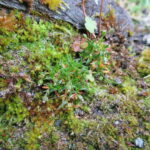
Snow pearlwort The first stop was a key population of snow pearlwort (Sagina nivalis). Ben Lawers NNR holds the entire UK population except for c.18 plants, and this arctic-alpine is threatened by climate change impacts. At 2 cm big it is definitely the most underappreciated and diminutive of the site’s rarities! The flowers only open on warm, sunny days and these individuals were still in shade during our visit.
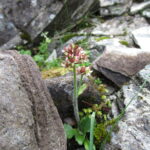
Alpine saxifrage The next find was made by Georgia, who spotted a fabulous (and unusually accessible) example of alpine saxifrage (Micranthes nivalis).
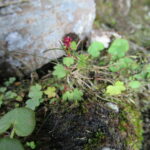
Drooping saxifrage Here we also encountered drooping saxifrage (Saxifraga cernua) complete with bright red bulbils from which vegetative reproduction occurs. It only features in two other hectads in Britain, with all sites located at extreme altitude. Unfortunately this means bad news as temperatures rise and snow cover varies due to climate change.
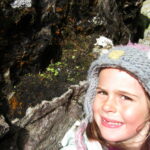
Georgia and drooping saxifrage
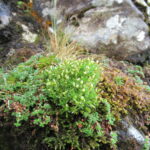
Mountain sandwort Following on was another rare upland member of the Caryophyllaceae, mountain sandwort (Sabulina rubella). This cushion-forming perennial herb is associated with strongly base-rich rocks including mica schists and limestone. The Ben Lawers population is the most southerly in the world and may also be struggling due to climate change.
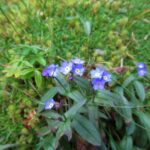
Alpine forget-me-not Shortly after we noticed the striking sky-blue flowers of alpine forget-me-not on high herbaceous ledges; again another species with a very limited distribution in Britain that has Ben Lawers as its primary location.
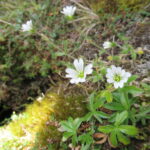
Arctic mouse-ear Arctic mouse-ear (Cerastium arcticum) made an appearance in some crevices further down our descent. It has particularly large white flowers for this genus and is scarcer than the closely related alpine mouse-ear (Cerastium alpinum). It is usually found in North-facing corries and has a complex taxonomic history in this country.
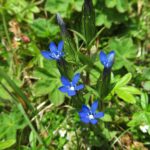
Alpine gentian Finally we reached a series of gently sloping wet rock slabs where I hoped to see the jewel of Ben Lawers, the alpine gentian (Gentiana nivalis). It is an annual which grows in short herb-rich calcareous vegetation and this NNR is one of its two sites in Scotland. Like the snow pearlwort the flowers only open in warm sunshine, but fortunately luck was on our side today. Though tiny, these glorious deep azure blue stars are an impressive picture. Georgia convinced me to continue the search on some higher slabs, and I’m so glad she did because there we found some relatively large multi-flowered individuals. This is certainly the best example of gentian flowering I have seen yet.
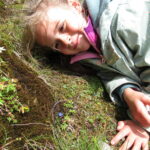
Georgia and alpine gentian
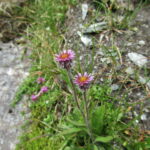
Alpine fleabane And just when we thought it couldn’t get any better, some delightful alpine fleabane (Erigeron borealis) came into view too!
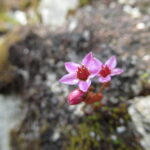
Hairy stonecrop These irrigated slabs are also home to an unusual population of hairy stonecrop (Sedum villosum). It is typically associated with bryophyte-rich flushes in hilly areas and sub-montane locations (250 – 500 m), but the Ben Lawers plants grow at a far higher altitude than anywhere else in the country (up to 1138 m). There is a hypothesis that they are a different montane ecotype than those from other northern British sites, and may therefore be particularly vulnerable to variations in annual temperature and snow lie.

Georgia and Felix on Beinn Ghlas